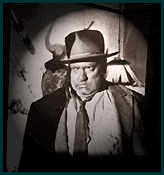Orson Welles and Russell Metty, ASC lent cinematic panache to TOUCH OF EVIL, a noir thriller whose script was rescued from the reject pile.
A policeman’s job is only easy in a police state," Charlton Heston tells Orson Welles in Touch of Evil. "That’s the whole point, Captain. Who’s the boss, the cop or the law?"
This rhetorical question lies at the heart of Welles’s moody and evocative 1958 movie. In exploring the time-tested theme, Welles, a wildly variegated cast and a sturdy Universal production crew lead viewers through a shadowy maze of strange people, crime, squalor and moral decay. The result is a 20th-century American version of a yarn that might have been spun by Charles Dickens or Victor Hugo.
The production history of Touch of Evil is almost as colorful as its story. Universal, renamed Universal-International following its merger with International Pictures, had purchased film rights to Whit Masterson’s pulp novel, Badge of Evil, and put it on producer Albert Zugsmith’s slate for the 1947-48 season. U-I had sworn off making B movies, but the studio had kept Zugsmith in the "nervous A" budget category because he specialized in "exploitation pictures." These made money because of their sensational qualities rather than extravagant production values. Most but not all were potboilers. Certainly the 1957 pictures The Incredible Shrinking Man and Written on the Wind were nothing to be ashamed of.
Dumping Zugsmith and Welles into the same crucible would seem as aberrant as pouring ketchup on ice cream. Given an almost generous budget (just short of $900,000) and a five-week shooting schedule, Zugsmith went all-out to gather a prestigious cast. He first signed Orson Welles, thus spurring the interest of Charlton Heston (who was in the spotlight for his performance as Moses in Cecil B. DeMille’s 1956 religious epic The Ten Commandments), and then hired the increasingly popular Janet Leigh. Heston okayed Paul Monash’s script, but said that his decision would ultimately depend upon who was chosen to direct. He dropped the hint that Welles himself was a pretty fair director.
Welles had not directed a movie in the United States since Republic’s Macbeth in 1948. He had recently returned from Europe to produce King Lear on Broadway, and was hoping to re-establish himself in American movies. According to Zugsmith, Welles asked which of his projects had the worst screenplay; the producer replied that it was probably Badge of Evil. Welles said he would direct the project if he could have two weeks to rewrite the script. It is probable that Welles was given the writer-director job (without extra pay) in order to lure in Heston and Leigh.
In his rewrite, Welles changed the tale’s locale from San Diego to the fictitious bordertown of Los Robles, a decaying dumping ground for criminals and other vagrants. The book’s hero, an Anglo detective with a Mexican wife, became lantern-jawed Mike Vargas (Heston), chairman of the Pan-American Narcotics Commission, whom we meet as he is honeymooning with his Anglo bride, Susan (Leigh). The two are walking on the United States side of the border checkpoint when they see a millionaire and a blond stripper blown to bits by an incendiary car bomb. Unofficially, Vargas joins famed American police captain Hank Quinlan (Welles) and his worshipful assistant, Pete Menzies (Joseph Calleia) in the investigation. When Vargas realizes that Quinlan is framing a Mexican youth for the crime, he becomes determined to expose the corrupt cop. He soon enlists the aid of Schwartz (Mort Mills), an assistant district attorney who points him toward evidence that Quinlan used manufactured evidence to send numerous murder suspects to death row.
Meanwhile, the leader of the Grandi gang, "Uncle Joe" (Akim Tamiroff), who hates Vargas for sending his brother to prison, connives with Quinlan against the upstanding attorney. As Vargas becomes enmeshed in his quest, Grandi’s goons terrorize Susan at an isolated motel, inject their terrified victim with sodium pentathol to make her appear to be a heroin addict, and deliver her to a sleazy hotel room. Arriving on the scene, Quinlan strangles Grandi and leaves the body on Susan’s bed.
However, even the faithful Menzies turns against Quinlan when he finds the captain’s cane near Grandi’s body. Torn by conflicting emotions, he wears a hidden mike and accompanies the drunken Quinlan on a nocturnal prowl through an oilfield dump. Vargas follows and records their conversation, which reveals Quinlan’s villainy. Catching onto the setup, Quinlan shoots his sidekick. He is about to kill Vargas as well, but the dying Menzies manages to gun down Quinlan in the nick of time.
Instead of using the Universal backlot’s bordertown set, Welles and art directors Alex Golitzen and Robert Clatworthy elected to transform areas of the colorful oceanfront city of Venice into Los Robles. A beautiful city built to resemble its Italian namesake complete with Mediterranean architecture, canals and gondoliers Venice had fallen on bad times. The waterways and bridges had gone to pot, many of the downtown buildings were run-down, and the area had become a high crime zone. Because most of the film’s exteriors were shot night-for-night, the city also proved to be a gigantic lighting job. There are many deep-focus shots looking up and down long streets past the landmark series of arches, some of which are still there today. To add the appropriate ambience, studio technicians dumped trash everywhere, and wind machines swirled the debris around.
Russell Metty, ASC, who was employed at U-I when Welles arrived, had previously shot the filmmaker’s 1946 effort The Stranger. The big, cigar-smoking cinematographer was just the man to put Welles’s wildest notions onto film.
[ continued on page 2 ]
